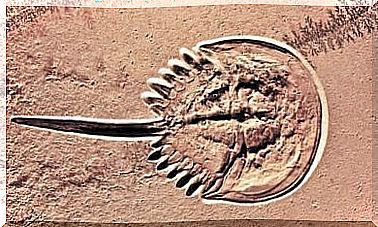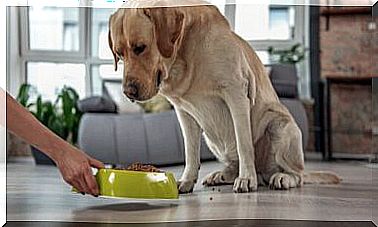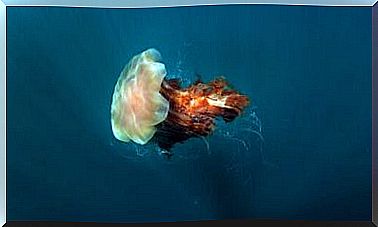Dog Burns: Prevention And Treatment
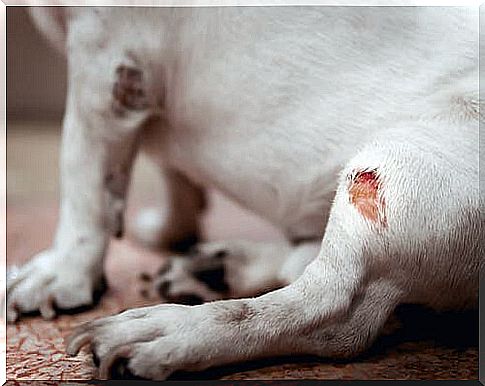
Dog burns can be caused by a variety of household accidents, which can include electrical equipment and hazardous chemicals.
Minor burns can be treated at home and only cause superficial damage. However, more severe burns require the care of a veterinarian. These injuries can cause serious and profound damage, sometimes within days of the accident.
Dog burns caused by accidents
In thermal burns, the main causes are the direct heat emitted by stoves, heaters, electric blankets, etc. Also common causes of thermal burns are exposure to fire flames, fireworks…
Electrical burns are also quite common in mischievous dogs, especially puppies. In electrical burns, the accident usually occurs when they bite electrical cords or other lighting devices.
Finally, in chemical burns, the accident occurs because of exposure to acids, solvents distilled from petroleum, gasoline, turpentine, kerosene or hot tar. This type of burn is usually more severe, and proper first aid is vital.
What should be evaluated in cases of dog burns
Dogs with superficial burns will show the common signs of pain. Also, the hair may be burned, but the skin intact.
In the case of third-degree burns, the skin will be partially or completely burned. These burns are known as partial-thickness and full-thickness burns and are much more severe. In these cases, it is important to check for signs of shock.
As detailed above, burns are primarily caused by one of three things: chemicals, electricity, and heat from hot liquids or objects. It is essential to determine the cause of the burn quickly so that it can be treated properly.
How to care for dog burns if they are superficial
The main rule of thumb for dog burns of any kind is to never apply ointments, creams, butter, or margarine. Applying ointments will never help your puppy heal faster.
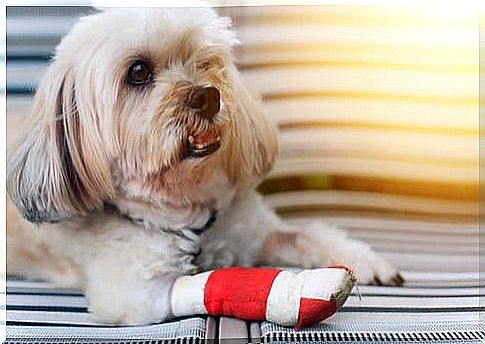
Superficial burns are burns in which the skin is burned but still intact. In these cases, treatment depends on what exactly caused the burn:
1. If it was caused by liquids or hot objects
Restrict the dog’s movement and cool the burned area as quickly as possible. You can do this with a gentle stream of cold water in the bathtub or with a shower attachment. The faster the area is cooled, the less damage will be.
Once the area has been washed with water, apply a cold compress for 20 minutes, using a bag of frozen vegetables, for example. Then cover the area with a non-stick dressing and finally contact your veterinarian for advice on further treatment.
2. If it was caused by chemical substances
Wear rubber gloves to prevent burns to your own hands. Then, remove the collar and clothing or guides that have been contaminated. Rinse the affected area with cold water for 20 minutes. Be sure not to spread the chemical so as not to burn other areas.
We do not recommend using shampoo or other types of soap as there is no way of knowing if they will react with the first chemical. In these cases, plenty of water is the best option.
If the burn is on the muzzle, put the dog on its side and pour in cold water using a mug or garden hose to get a steady, fresh flow. After rinsing with water, cover superficial burns with a non-stick dressing and consult your veterinarian for advice on additional treatments.
3. If it was caused by electrical shock
Dog burns from electrical equipment or power cords can be treated in the same way as burns from hot liquids or objects. However, before touching the dog or the cables around it, make sure the source of electricity has been cut off.
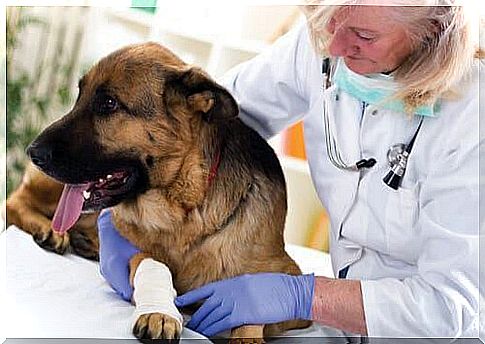
How to care for partial or full thickness burns
For more severe burns, in which the skin is partially or completely burned, it is recommended to follow these guidelines:
- If you are not able to go to a local veterinary hospital immediately, you can begin treatment by trimming the hairs in the area. Then clean with saline solution and apply silver sulfadiazine ointment, which you should always keep in your dog’s first-aid kit.
- Then cover the area with sterile, dry dressings. Be careful and avoid using fabrics with loose fibers, like cotton, for example, as the threads will stick to the wound and cause even more problems.
- Finally, wrap the area with clean, torn sheets. Take the dog to the vet immediately.
The treatment of burns in dogs can be complicated and time-consuming. In most cases, treatment involves giving analgesics and using antibiotics to prevent secondary infections.
It is also necessary to make frequent dressing changes, surgical procedures for debridement or skin grafts, and shock management. The veterinarian will provide guidance on proper monitoring of your dog’s burns.

